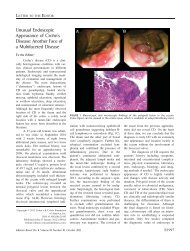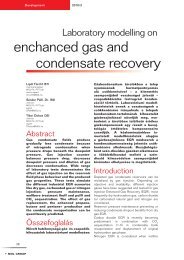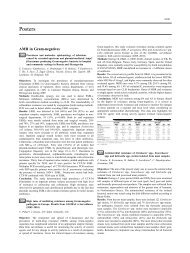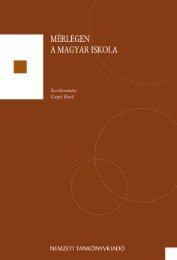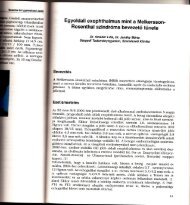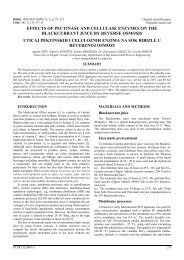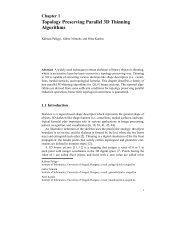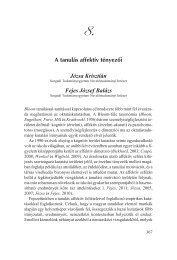View - ResearchGate
View - ResearchGate
View - ResearchGate
Create successful ePaper yourself
Turn your PDF publications into a flip-book with our unique Google optimized e-Paper software.
Authors version, the file is not the final published version of the paper.<br />
The published source, Acta Microbiologica et Immunologica Hungarica is<br />
acknowledged.<br />
Publisher version: http://dx.doi.org/10.1556/AMicr.51.2004.3.5<br />
ETEST FOR ASSESSING THE SUSCEPTIBILITY OF FILAMENTOUS FUNGI*<br />
ILONA DÓCZI 1 , ERIKA DÓSA 1 , J. VARGA 2 , ZSUZSANNA ANTAL 3 , L. KREDICS 3 ,<br />
ELIZABETH NAGY 1,3<br />
1 Department of Clinical Microbiology, Faculty of Medicine, University of Szeged, Somogyi<br />
Béla tér 1, H-6725 Szeged, Hungary, 2 Department of Microbiology, Faculty of Sciences,<br />
University of Szeged, P.O. Box 533, H-6701 Szeged, Hungary, 3 Hungarian Academy of<br />
Sciences and University of Szeged, Microbiological Research Group, P.O. Box 533, H-6701<br />
Szeged, Hungary<br />
*Dedicated to the 100 th anniversary of the birth of Professor György Ivánovics<br />
Running title: ETEST OF FILAMENTOUS FUNGI<br />
Keywords: Moulds, antifungal susceptibility testing, minimal inhibitory concentration, Etest,<br />
agar dilution<br />
1
Abstract<br />
The purpose of this study was to evaluate the Etest as an in vitro antifungal<br />
susceptibility test method for different moulds originating from human samples and from the<br />
environment. A total of 50 isolates (1 Acremonium, 18 Aspergillus, 2 Cladosporium,<br />
1 Epicoccum, 15 Penicillium, 2 Scopulariopsis and 11 Trichoderma strains) were tested by<br />
the Etest. 46 of the tested moulds (92%) were resistant to fluconazole with minimal inhibitory<br />
concentrations (MICs) ≥ 256 µg ml −1 . There were strains resistant to itraconazole among<br />
Aspergillus niger, Aspergillus ochraceus and Cladosporium spp. with MICs > 32 µg ml −1 . For<br />
fluconazole, no differences were observed using two different inocula, while for itraconazole,<br />
ketoconazole and amphotericin B, a 1 or less step 2-fold dilution difference in MIC was seen<br />
for the most of 10 selected strains. The MICs of fluconazole and amphotericin B obtained for<br />
Trichoderma strains by the Etest and the agar dilution method were also compared. MICs for<br />
fluconazole were in agreement, while MICs for amphotericin B were higher with 1 or 2 steps<br />
of 2-fold dilutions for most of Trichoderma strains in the case of the agar dilution method.<br />
2
Introduction<br />
The incidence of fungal infections has been increasing since the 1980s. The increasing<br />
number of susceptible hosts (organ or bone marrow transplant patients) as well as the use of<br />
immunsuppressive agents and antimicrobial prophylactic strategies has probably contributed<br />
to the changing epidemiology of mycoses [1]. The volume of disseminated infections caused<br />
by filamentous fungi (moulds) is lower than that caused by yeasts [2]. Most infections caused<br />
by moulds originate from the environment by inhalation through the respiratory tract or<br />
contamination (e.g. postoperative wounds, heart valves, etc.) [3]. The most frequently isolated<br />
moulds are Aspergillus spp.: A. fumigatus is responsible for a large majority (85-90%) of the<br />
different clinical manifestations of several mould infections [2]. However, the importance of<br />
other moulds (Penicillium, Cladosporium and Scopulariopsis spp.) has also been increasing.<br />
Moulds are able to cause infections of the respiratory tract (e.g. pneumonia, allergic<br />
bronchopulmonary mycosis, aspergilloma, allergic fungal rhinosinusitis, etc.) and superficial,<br />
cutaneous, osseous or invasive mould infections [4–10].<br />
The in vitro susceptibility testing of filamentous fungi is becoming increasingly<br />
important because of the frequency and diversity of the infections they cause [11]. The<br />
standard method for determination of the MICs of filamentous fungi (the NCCLS broth<br />
microdilution method [12, 13]) and the Etest were compared in previous studies [2, 14, 15]. In<br />
the case of many moulds, good correlations have been demonstrated for amphotericin B and<br />
itraconazole, but the results depended on the species tested and the nutrient media used for<br />
susceptibility testing [2, 14].<br />
This report summarizes the antifungal susceptibility results on filamentous fungi<br />
isolated from clinical specimens and from the environment, obtained by the Etest method.<br />
3
Isolates<br />
Materials and methods<br />
A total number of 50 isolates were tested, including 44 clinical isolates obtained from<br />
different specimens (from the upper or lower respiratory tract, the gastrointestinal tract, the<br />
genital tract or the peritoneal fluid as well as mucocutaneous samples). Strains were isolated<br />
from Sabouraud chloramphenicol agar (Sanofi Diagnostics Pasteur, Marnes-La-Coquette,<br />
France) and maintained on Sabouraud chloramphenicol agar slants until use in this study. The<br />
clinical isolates included 7 Trichoderma strains obtained from the American Type Culture<br />
Collection (Manassas, USA) and the University of Alberta Microfungus Collection and<br />
Herbarium, these strains originated from immunosuppressed patients with various infections.<br />
Among 6 strains originating from the environment, 4 Trichoderma isolates were studied<br />
earlier for cold tolerance [16].<br />
All isolates were subcultured on Sabouraud chloramphenicol agar plates and incubated<br />
at 30 °C until adequate growth was attained before their use in susceptibility testing.<br />
Etest for MIC determinations<br />
The Etest was performed according to the manufacturer’s instructions (AB Biodisk;<br />
Solna, Sweden) [17]. Spore suspensions were adjusted to match the 0.5 McFarland standard.<br />
The medium used was RPMI 1640 agar (15 g l −1 ) supplemented with 20 g l −1 glucose. This<br />
medium was dispensed in 20 ml amounts into Petri dishes (90 mm in diameter) giving an agar<br />
depth of 4 ± 0.5 mm. These plates were inoculated by dipping a sterile swab into the inoculum<br />
suspension and streaking it across the entire surface in three directions. The plates were dried<br />
at room temperature for 15 min before the application of the Etest strips. (The drug<br />
4
concentrations ranged from 0.016 to 256 mg l −1 for fluconazole, and from 0.002 to 32 mg l −1<br />
for itraconazole, ketoconazole and amphotericin B). The plates were incubated at 30 °C and<br />
read after incubation for 24, 48 or 72 hours according to the growth conditions of the isolates.<br />
The MIC was read as the drug concentration at which the elliptical inhibition zone intersected<br />
the scale on the antifungal test strip.<br />
Agar dilution method<br />
The susceptibility of Trichoderma strains was evaluated for fluconazole and<br />
amphotericin B by the agar dilution method as well [18]. Stock solutions of 2 mg ml −1 were<br />
prepared from amphotericin B (Bristol-Myers Squibb AG, Baar) and fluconazole (Pfizer,<br />
Amboise, France) in sterile distilled water. 20 ml aliquots of RPMI 1640 agar (15 g l −1 )<br />
supplemented with 20 g l −1 glucose were used to fill the 90-mm-diameter Petri dishes.<br />
Appropriate quantities of the stock solutions were added to the molten and cooled medium to<br />
reach final concentrations of 4–512 µg ml −1 for fluconazole and 0.25–32 µg ml −1 for<br />
amphotericin B, corresponding to the Etest concentrations. The medium was mixed and<br />
allowed to solidify undisturbed. Control plates containing the test medium without<br />
antimicrobial agents were prepared for each strain.<br />
3-mm-diameter discs were cut from the edges of young colonies of Trichoderma<br />
strains [16]. One disc was inoculated onto each plate, and the plates were then incubated at<br />
30 °C for 48 hours. The MIC was read as the lowest drug concentration at which no growth of<br />
the microorganisms was detected.<br />
5
Results<br />
During the past years (2000-2002), 50 filamentous fungi originating from different<br />
specimens were evaluated. Table I shows the origin and distribution of the isolates. No<br />
parallel isolates from the same patient were involved in the study.<br />
32 human isolates were cultured from specimens from the upper or lower respiratory<br />
tract: mucin from the nose, washing fluid from the paranasal sinuses or nose, specimens from<br />
the ears or thoracic fluid. 3 isolates were from the peritoneal fluid, 4 from the gastrointestinal<br />
tract, 3 from mucocutaneous samples and 2 from the genital tract. The most frequently<br />
isolated species were A. versicolor among the Aspergillus spp. and P. chrysogenum among<br />
the Penicillium spp. The 6 isolates from environmental samples were Epicoccum nigrum (1),<br />
Scopulariopsis spp. (1), T. citrinoviride (1), T. koningii (1), T. longibrachiatum (1) and T.<br />
pseudokoningii (1).<br />
These fungi were tested and evaluated for their susceptibilities to fluconazole,<br />
ketoconazole, itraconazole and amphotericin B by the Etest (Table II). 46 of the tested moulds<br />
(92%) were resistant to fluconazole, with MIC >256 µg ml −1 . The range of MICs for<br />
ketoconazole was wide: there were resistant strains with MICs >32 µg ml −1 among the A.<br />
niger, A. ochraceus and Cladosporium spp., while the lowest MIC values were obtained for<br />
the Trichoderma strains (0.008−0.5 µg ml −1 ). Two strains were resistant to amphotericin B<br />
with MIC values >32 µg ml −1 .<br />
For 10 selected isolates, the MICs obtained by the Etest were measured by using two<br />
different spore suspension turbidities. The MICs obtained after incubation for 48 or 72 hours<br />
are listed in Table III. For fluconazole, no differences were observed with the two inocula: all<br />
strains were fully resistant. For itraconazole, ketoconazole and amphotericin B, a 1- or 2-step<br />
2-fold dilution difference in MIC was seen for most strains with the exception of A. niger 2.<br />
6
and A. ochraceus: significant differences in MICs were detected for ketoconazole and<br />
itraconazole in the case of these two strains.<br />
The MICs of fluconazole and amphotericin B obtained for 10 Trichoderma strains by<br />
the Etest and the agar dilution method were compared. Table IV presents these results<br />
together with data from appropriate references. The MICs of fluconazole obtained for 8<br />
strains with the two methods were in agreement, but higher values were obtained by the Etest<br />
for strain T. koningii T 39. Higher MICs were obtained for amphotericin B with the agar<br />
dilution method than with the Etest in the case of 7 strains.<br />
7
Discussion<br />
Most of the infections caused by moulds originate from the environment. These fungi<br />
pass into the human body through breathing, food or contamination. During the past two<br />
years, moulds were isolated most frequently from the upper respiratory tract. Predominantly<br />
these areas (nose, paranasal sinuses and ears) are exposed to fungal spores. Isolates from the<br />
gastrointestinal tract originated from contaminated food: most of these fungi are evacuated<br />
from the organism, but they may be the origin of serious mould infections in<br />
immunosuppressed patients [20]. The rates of Aspergillus spp. (18 isolates) and Penicillium<br />
spp. (15 isolates) in human specimens during the 2-year period were similar. Acremonium<br />
spp., Cladosporium spp. and Scopulariopsis spp. were isolated in small numbers.<br />
There have been previous reports on comparisons of antifungal susceptibility testing<br />
methods for moulds [2, 14, 15], and a good correlation was observed between the Etest and<br />
broth microdilution methods. In this present study, most strains were resistant to fluconazole<br />
by the Etest (Table II), while ketoconazole, itraconazole and amphotericin B were more<br />
effective. For most strains, the MICs were not influenced significantly by the turbidity of<br />
spore suspension (Table III). For 8 of 10 strains, there were no or only small differences<br />
between the MICs obtained on the use of 3 McFarland and 0.5 McFarland suspensions (in<br />
accordance with the manufacturer’s instruction). If the higher inoculum was used for some<br />
slow-growing isolates, the MICs could be read 1 day earlier. Higher differences were detected<br />
for 2 Aspergillus strains: A. niger and A. ochraceus. The MICs of these strains for<br />
amphotericin B and fluconazole did not differ markedly, and were similar to the itraconazole<br />
MIC of A. ochraceus. These moulds grew rapidly and covered the surface of the agar plates<br />
completely (with the exception of the inhibition zone) when a higher turbidity of suspension<br />
was used. The cultures were thicker, which influenced the MICs. More exact values could be<br />
8
obtained if the turbidity of the spore suspension was measured spectrophotometrically in the<br />
case of black moulds.<br />
The differences in MIC values obtained by comparison of the Etest and the agar<br />
dilution methods were similar for the evaluated Trichoderma strains (Table IV). The MICs for<br />
fluconazole did not differ markedly with these methods, but they did differ by 1 or 2 steps of<br />
2-fold dilutions from the data in the literature obtained by broth dilution methods. The MICs<br />
for amphotericin B were higher by 1 or 2 steps of 2-fold dilutions with the agar dilution<br />
method.<br />
In conclusion, these data indicated differences between the susceptibility testing<br />
methods for moulds. The agar dilution method was not the most appropriate for the<br />
susceptibility testing of moulds in routine laboratory use, because the exact results depended<br />
on numerous features (e.g. the stability of the solution of antimycotics, the mixing of the stock<br />
solutions into the agar medium, the growth rate of the moulds, etc.). The Etest is easier to<br />
perform: it is less labour-intensive and much simpler to set up than the broth microdilution or<br />
agar dilution methods [2, 15] and it provides the flexibility to test antifungal agents against<br />
different moulds [14].<br />
Acknowledgements.This study was supported in part by grant OTKA F037663 of the<br />
Hungarian Scientific Research Fund. We thank Pfizer for supplying the Etests.<br />
9
References<br />
1. Singh,N.: Trends in the epidemiology of opportunistic fungal infections: predisposing<br />
factors and the impact of antimicrobial use practices. Clin Infect Dis 33, 1692–1696<br />
(2001).<br />
2. Espinel-Ingroff,A.: Comparison of the E-test with the NCCLS M38-P method for<br />
antifungal susceptibility testing of common and emerging pathogenic filamentous<br />
fungi. J Clin Microbiol 39, 1360–1367 (2001).<br />
3. Muñoz,P., Burillo,A., Bouza,E.: Environmental surveillance and other control<br />
measures in the prevention of nosocomial fungal infections. Clin Microbiol Infect 7<br />
(Suppl 2), 38–45 (2001).<br />
4. Rodríguez-Hernández,M.J., Jiménez-Mejías,M.E., Montero,J.M., Regordan,C.,<br />
Ferreras,G.: Aspergillus fumigatus cranial infection after accidental traumatism. Eur J<br />
Clin Microbiol Infect Dis 20, 655–656 (2001).<br />
5. Karpovich-Tate,N., Dewey,F.M., Smith,E.J., Lund,V.J., Gurr,P.A., Gurr,S.J.:<br />
Detection of fungi in sinus fluid of patients with allergic fungal rhinosinusitis. Acta<br />
Otolaryn 120, 296–302 (2000).<br />
6. Revankar,S.G.: Superficial and cutaneous mycoses. Mycol Newslett November, 18<br />
(1998).<br />
7. Latgé,J.P.: Aspergillus fumigatus and aspergillosis. Clin Microbiol Rev 12, 310–350.<br />
(1999).<br />
8. Baddley,J.W., Stroud,T.P., Salzman,D., Pappas,P.G. Invasive mold infections in<br />
allogeneic bone marrow transplant recipients. Clin Infect Dis 32, 1319–1324 (2001).<br />
10
9. Yeghen,T., Fenelon,L., Campbell,C.K., Warnock,D.W., Hoffbrand,A.V.,<br />
Prentice,H.G., Kibbler,C.C. Chaetomium pneumonia in patient with acute myeloid<br />
leukaemia. J Clin Pathol 49, 184–186 (1996).<br />
10. Hattori,N., Adachi,M., Kaneko,T., Shimozuma,M., Ichinohe,M., Iozumi,K.: Case<br />
report. Onychomycosis due to Chaetomium globosum successfully treated with<br />
itraconazole. Mycoses 43, 89–92 (2000).<br />
11. Meletiadis,J., Meis,J.F.G.M., Mouton,J.W., Verweij,P.E.: Analysis of growth<br />
characteristics of filamentous fungi in different nutrient media. J Clin Microbiol 39,<br />
478–484 (2001).<br />
12. National Committee for Clinical Laboratory Standards: Reference Method For Broth<br />
Dilution Antifungal Susceptibility Testing Of Yeasts. Approved standard M27-A.<br />
National Committee for Clinical Laboratory Standards, Wayne, PA. 1997<br />
13. National Committee for Clinical Laboratory Standards: Reference method for broth<br />
dilution antifungal susceptibility testing of conidium forming filamentous fungi.<br />
Proposed standard M38-P. National Committee for Clinical Laboratory Standards,<br />
Wayne, PA. 1998<br />
14. Pfaller,M.A., Messer,S.A., Mills,K., Bolmström,A.: In vitro susceptibility testing of<br />
filamentous fungi: Comparison of Etest and reference microdilution methods for<br />
determining itraconazole MICs. J Clin Microbiol 38, 3359–3361 (2000).<br />
15. Szekely,A., Johnson,E.M., Warnock,D.W.: Comparison of E-Test and broth<br />
microdilution methods for antifungal drug susceptibility testing of molds. J Clin<br />
Microbiol 37, 1480–1483 (1999).<br />
16. Antal,Z., Manczinger,L., Szakács,G., Tengerdy,R.P., Ferenczy,L.: Colony growth, in<br />
vitro antagonism and secretion of extracellular enzymes in cold-tolerant strains of<br />
Trichoderma species. Mycol Res 104, 545–549 (2000).<br />
11
17. Etest technical guide No. 4: Antifungal Susceptibility Testing Of Moulds. AB Biodisk,<br />
Solna, Sweden.<br />
18. Victor,L.: Antibiotics in laboratory medicine. Second Edition. Baltimore, U.S.A, 1986<br />
19. Campos-Herrero,M.I., Bordes,A., Perera,A., Ruiz,M.C., Fernandez,A.: Trichoderma<br />
koningii peritonitis in a patient undergoing peritoneal dialysis. Clin Microbiol<br />
Newslett 18, 150–152 (1996).<br />
20. Richter,S., Cormican,M.G., Pfaller,M.A., Lee,C.K., Gingrich,R., Rinaldi,M.G.,<br />
Sutton,D.A.: Fatal disseminated Trichoderma longibrachiatum infection in an adult<br />
bone marrow transplant patient: Species identification and review of the literature. J<br />
Clin Microbiol 37, 1154–1160 (1999).<br />
21. Munoz,F.M., Demmler,G.J., Travis,W.R., Odgen,A.K., Rossmann,S.N., Rinaldi,M.G.:<br />
Trichoderma longibrachiatum infection in a pediatric patient with aplastic anemia. J<br />
Clin Microbiol 35, 499–503 (1997).<br />
Addresses of the authors:<br />
Corresponding author: Prof. Elizabeth Nagy: Department of Clinical Microbiology,<br />
Faculty of Medicine, University of Szeged, Somogyi Béla tér 1, H-6725 Szeged, Hungary, E-<br />
mail: nagye@mlab.szote.u-szeged.hu<br />
Ilona Dóczi, Erika Dósa: same address as above<br />
Dr. Zsuzsanna Antal, Dr. László Kredics: Hungarian Academy of Sciences and University<br />
of Szeged, Microbiological Research Group, P.O. Box 533, H-6701 Szeged, Hungary<br />
Dr. János Varga: Department of Microbiology, Faculty of Sciences, University of Szeged,<br />
P.O. Box 533, H-6701 Szeged, Hungary<br />
12
Species<br />
Gastrointestinal<br />
tract<br />
Table I<br />
Origin of moulds evaluated for antifungal susceptibility<br />
Upper and<br />
lower<br />
respiratory tract<br />
No. of isolates<br />
Peritoneal<br />
fluid<br />
Mucocutaneous<br />
samples<br />
Genital<br />
tract<br />
Environmental<br />
samples<br />
Total No. of isolates<br />
(% of all)<br />
Acremonium spp. 0 1 0 0 0 0 1 (2%)<br />
A. candidus 0 1 0 0 0 0 1 (2%)<br />
A. fumigatus 0 4 0 0 0 0 4 (8%)<br />
A. niger 0 4 0 1 0 0 5 (10%)<br />
A. ochraceus 0 2 0 0 0 0 2 (4%)<br />
A. versicolor 0 3 0 1 2 0 6 (12%)<br />
Cladosporium spp. 0 2 0 0 0 0 2 (4%)<br />
E. nigrum 0 0 0 0 0 1 1 (2%)<br />
P. chrysogenum 0 6 0 0 0 0 6 (12%)<br />
P. humicola 2 0 0 0 0 0 2 (4%)<br />
P. humuli 0 4 0 0 0 0 4 (8%)<br />
Penicillium spp. 0 3 0 0 0 0 3 (6%)<br />
Scopulariopsis spp. 1 0 0 0 0 1 2 (4%)<br />
T. citrinoviride 0 0 1 0 0 1 2 (4%)<br />
T. koningii 0 0 1 0 0 1 2 (4%)<br />
T. longibrachiatum 1 2 1 1 0 1 6 (12%)<br />
T. pseudokoningii 0 0 0 0 0 1 1 (2%)<br />
Total 4 32 3 3 2 6 50 (100%)<br />
14
Species (No. of tested<br />
isolates)<br />
Table II<br />
Antifungal susceptibilities of moulds evaluated by the Etest method<br />
(Range of) MICs (µg ml −1 Incubation<br />
)<br />
time (h) Fluconazole Ketoconazole Itraconazole Amphotericin B<br />
Acremonium spp. (1) 72 >256 0.5 >32 2<br />
A. candidus (1) 72 >256 0.032 0.004 8<br />
A. fumigatus (4) 48 >256 0.125 – 4 0.25 – 1 0.016 – 2<br />
A. niger (5) 24, 48 8 - >256 0.016 – >32 0.032 – 4 0.25 – 1<br />
A. ochraceus (2) 48 >256 2 and >32 1 and 4 8 and >32<br />
A. versicolor (6) 48, 72 >256 0.064 – 0.5 0.125 – 2 0.032 – 16<br />
Cladosporium spp. (2) 48, 72 >256 0.064 and >32 0.5 and 1 0.032 and 2<br />
E. nigrum (1) 72 >256 0.016 0.016 0.125<br />
P. chrysogenum (6) 48, 72 >256 0.25 – 1 0.125 - >32 4 – >32<br />
P. humicola (2) 48 >256 0.25 and 0.5 8 and >32 8<br />
P. humuli (4) 48, 72 64 and >256 0.25 – 1 0.064 – 2 0.125 – 1<br />
Penicillium spp. (3) 48, 72 >256 0.125 – 0.5 1 – 2 0.25 – 8<br />
Scopulariopsis spp. (2) 48 >256 0.125 and 1 1 and >32 0.5 and 1<br />
T T. citrinoviride (2) 48 >256 0.25 and 0.5 24 0.064 and 2<br />
T T. koningii (2) 48 >256 0.25 2 and 4 0.5 and 8<br />
T T. longibrachitaum (6) 48 8 - >256 0.008 – 0.5 1 – 32 1 – 2<br />
T T. pseudokoningii (1) 48 >256 0.25 8 0.25<br />
15
Species McFarland<br />
Table III<br />
Influence of turbidity of spore suspension on MICs<br />
MICs (µg ml −1 Incubation<br />
)<br />
time (h) Fluconazole Ketoconazole Itraconazole Amphotericin B<br />
A. fumigatus 1. 0.5 48 >256 2 1 0.25<br />
3 48 >256 4 1 0.5<br />
A. fumigatus 2. 0.5 48 >256 4 0.25 0.016<br />
3 48 >256 4 0.25 0.016<br />
A. niger 1. 0.5 48 >256 2 2 0.25<br />
3 48 >256 2 2 0.25<br />
A. niger 2. 0.5 48 >256 0.5 4 0.25<br />
3 48 >256 >32 32 0.5<br />
A. ochraceus 0.5 48 >256 2 1 >32<br />
3 48 >256 >32 2 >32<br />
A. versicolor 0.5 72 >256 0.125 1 0.25<br />
3 72 >256 0.25 1 0.5<br />
P. humuli 0.5 72 >256 0.5 2 1<br />
3 48 >256 0.5 2 1<br />
Penicillium spp. 0.5 72 >256 0.5 2 8<br />
3 48 >256 0.5 2 8<br />
Scopulariopsis spp. 0.5 48 >256 1 1 0.5<br />
3 48 >256 2 1 0.5<br />
S. brevicaulis 0.5 72 >256 0.125 >32 1<br />
3 48 >256 0.25 >32 1<br />
16
Table IV<br />
MIC values obtained by Etest and agar dilution method for Trichoderma spp.<br />
Species Identity<br />
MIC values (µg ml −1 )<br />
Fluconazole Amphotericin B<br />
Etest Agar dilution Etest Agar dilution<br />
T. citrinoviride UAMH 9573 64 64 2 2<br />
T. koningii T 39 >256 64 0.5 2<br />
T. koningii CM 382 a >256 512 8 16<br />
T. longibrachiatum TK 51 >256 256 2 4<br />
T. longibrachiatum UAMH 7955 >256 256 1 4<br />
T. longibrachiatum UAMH 7956 b 64 64 2 8<br />
T. longibrachiatum UAMH 9515 >256 512 2 4<br />
T. longibrachiatum ATCC 201044 c 64 32 2 2<br />
T. longibrachiatum ATCC 208859 >256 256 2 4<br />
T. pseudokoningii T 29 >256 256 0.25 0.25<br />
a Ref. 19: MICs : fluconazole: 128 µg ml −1 ; amphotericin B: 4 µg ml −1 (by broth microdilution method)<br />
b Ref. 20: MICs: fluconazole: 16 µg ml −1 ; amphotericin B: 2 µg ml −1 (by broth microdilution method)<br />
c Ref. 21: MICs: fluconazole: ?64 µg ml −1 ; amphotericin B: 2 µg ml −1 (by broth macrodilution method)<br />
17



